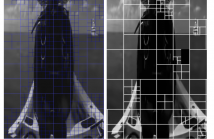
- Read more about Image Pre-Transformation for Recognition-Aware Image Compression
- Log in to post comments
- Categories:
 90 Views
90 Views
- Read more about Two-layer Near-lossless HDR Coding with Backward Compatibility to JPEG
- Log in to post comments
- Categories:
 13 Views
13 Views
- Read more about RATE-DISTORTION OPTIMIZED TREE-STRUCTURED POINT-LATTICE VECTOR QUANTIZATION FOR COMPRESSION OF 3D POINT CLOUDS GEOMETRY
- Log in to post comments
This paper deals with the current trends of new compression methods for 3D point cloud contents required to ensure efficient transmission and storage.
The representation of 3D point clouds geometry remains a challenging problem, since this signal is unstructured.
In this paper, we introduce a new hierarchical geometry representation based on adaptive Tree-Structured Point-Lattice Vector Quantization (TSPLVQ).
This representation enables hierarchically structured 3D content that improves the compression performance for static point clouds.
- Categories:
 26 Views
26 Views
- Read more about AN AFFINE-LINEAR INTRA PREDICTION WITH COMPLEXITY CONSTRAINTS
- 1 comment
- Log in to post comments
This paper presents a novel method for a data-driven training of
affine-linear predictors which perform intra prediction in state-ofthe-
art video coding. The main aspect of our training design is the
use of subband decomposition of both the input and the output of the
prediction. Due to this architecture, the same set of predictors can be
shared across different block shapes leading to a very limited memory
requirement. Also, the computational complexity of the resulting
predictors can be limited such that it does not exceed the complexity
- Categories:
 29 Views
29 Views
- Read more about EFFICIENT CODING OF 360° VIDEOS EXPLOITING INACTIVE REGIONS IN PROJECTION FORMATS
- Log in to post comments
This paper presents an efficient method for encoding common projection formats in 360◦ video coding, in which we exploit inactive regions. These regions are ignored in the reconstruction of the equirectangular format or the viewport in virtual reality applications. As the content of these pixels is irrelevant, we neglect the corresponding pixel values in ratedistortion optimization, residual transformation, as well as inloop filtering and achieve bitrate savings of up to 10%.
poster04.pptx
- Categories:
 27 Views
27 Views
- Read more about Real-Time HDR Video Tone Mapping Using High Efficiency Video Coding
- Log in to post comments
High-dynamic-range (HDR) video streams have been delivered through high-efficiency video coding (HEVC). HDR video tone mapping is required additionally but is operated separately to adjust the content’s dynamic range for each display device. HDR video tone mapping and HEVC encoding share common computational processes for spatial and temporal coherence in a video stream; however, they have been developed and implemented independently with their own computational budgets.
- Categories:
 70 Views
70 Views
- Read more about Discrete Cosine Basis Oriented Motion Modeling for Fisheye and 360 Degree Video Coding
- Log in to post comments
Motion modeling plays a central role in video compression. This role is even more critical in fisheye video sequences
since the wide-angle fisheye imagery has special characteristics as in exhibiting radial distortion. While the translational motion model employed by modern video coding standards, such as HEVC, is sufficient in most cases, using higher order models is
beneficial; for this reason, the upcoming video coding standard, VVC, employs a 4-parameter affine model. Discrete cosine basis
- Categories:
 16 Views
16 Views
- Read more about EFFICIENT SCREEN CONTENT CODING BASED ON CONVOLUTIONAL NEURAL NETWORK GUIDED BY A LARGE-SCALE DATABASE
- Log in to post comments
Screen content videos (SCVs) are becoming popular in many applications. Compared with natural content videos (NCVs), the SCVs have different characteristics. Therefore, the screen content coding (SCC) based on HEVC adopts some new coding tools (intra block copy and palette mode etc.) to improve coding efficiency, but these tools increase the computational complexity as well. In this paper, we propose to predict the CU partition of the SCVs by a convolutional neural network
- Categories:
 51 Views
51 Views
- Read more about Fast Inpainting-based Compression: Combinging Shepard Interpolation with Joint Inpainting and Prediction
- Log in to post comments
Inpainting-based compression has been suggested as a qualitative competitor to the JPEG family of transform-based codecs, specifically for high compression ratios. However, it also requires sophisticated interpolation, data optimisation and encoding tasks that are both slow and hard to implement. We propose a fast and simple alternative that combines Shepard interpolation with a novel joint inpainting and prediction approach. It represents the image by a fraction of its pixel values on a sparse regular subgrid that are selected by an efficient optimisation strategy.
- Categories:
 19 Views
19 Views
- Read more about MULTI-CHANNEL MULTI-LOSS DEEP LEARNING BASED COMPRESSION MODEL FOR COLOR IMAGES
- Log in to post comments
Lossy image compression aims to encode images with a low bit-rate representation while preserving a pleasant visual quality of decompressed images. By utilizing the manually designed features, the traditional compression may not be suitable for diverse image content and may cause visible artifacts under the low bit rate constraint. Recently, deep learning based methods, which can extract the compact representation of an image in an auto-encoder way, were proposed for image compression.
- Categories:
 50 Views
50 Views